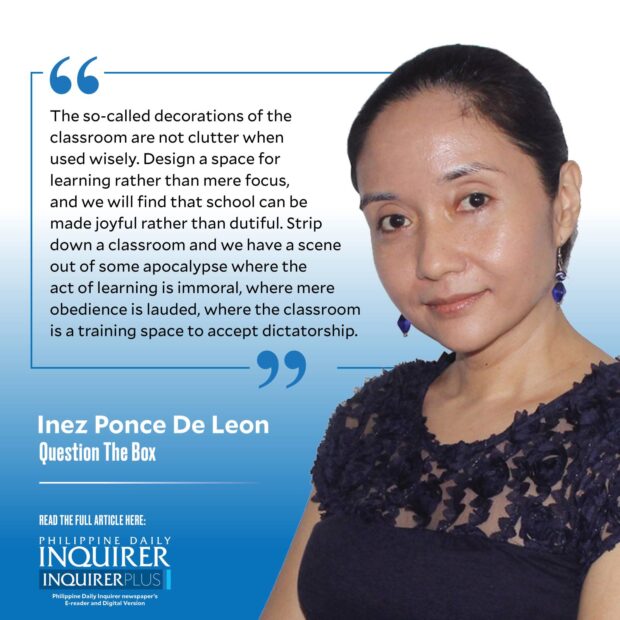Learning havens, not bare classrooms
 In recent days, social media has been littered with photos of teachers responding to the Department of Education’s call to remove clutter so that students can focus better.
In recent days, social media has been littered with photos of teachers responding to the Department of Education’s call to remove clutter so that students can focus better.
Research on the relationship between the appearance of a classroom and student learning has been growing in recent years, especially regarding students with learning disorders. In general, the research says: Less clutter is better.
The findings, some researchers suggest, could be extended to all students, who already live in an overwhelming digital world. But as with all research, we need to examine the claims. We have to ask: What is defined as clutter?
To the researchers, clutter is an item that has no impact on student learning, e.g., outdated equipment, materials that haven’t been used in more than two years, paraphernalia disputed by research (who can forget the now useless “map of the human tongue”?).And as with all research, there’s more to simply taking the findings wholesale. Researchers do not advocate for tearing down everything but the walls—they actually advise teachers to make students take ownership of the space, to ask what the students want to see, need to see, would like displayed. Students are then forced to articulate what they find difficult to learn, without being ashamed of the challenges they face.
Researchers in New Zealand and the United Kingdom, for instance, documented the results of their decluttering work, which had led to more focused students and calmer teachers: no open shelving, keeping some wall spaces blank for times when students needed to face somewhere to use their full concentration, removing unnecessary or outdated posters and replacing them with updated ones that would help students retain information in that year’s subjects, and enlisting the help of students to make the design decisions that would turn the space into a learning haven.
Decluttering, then, is not a bare wall, but a deliberate approach to classroom design: designating spaces, rearranging chairs, putting things on the wall that can facilitate interactive learning. The key is to define students as learners who need to be trained to sift through information, not perpetual kids already drowning in it.
The sight that greeted the local mandate, however, was that of teachers simply cleaning out classrooms minus the input of students, based on orders handed down. There was neither deliberation nor nuance in the act.
To examine why this brashness is possibly detrimental to long-term education goals, we have to look closely at our classrooms. Our decorations might include the alphabet, evolutionary timelines, photos of presidents past.
Now, let’s think of what these so-called decorations mean. The alphabet, timelines, and photos can be moved to the back of the classroom if they feel unnecessary to the topic at hand; but they are no mere things. They are the legacy to the next generation of students, a reminder that there is history that dwarfs us all, but that represents us. We are citizens with a long history of conquest by foreigners and oppression by our own countrymen, including during martial law. The posters help our students remember.
The posters also remind us that learning happens everywhere, even when the teacher and blackboard disappear. They remind us that even when the lectures end, all the lessons still apply.
A simplistic model of “concentrate on the blackboard” is akin to saying that students will learn nothing unless ordered by an authority. This mentality fosters early socialization into the notion that one cannot learn on one’s own, that one is so stupid as to have no capacity to swim through seas of knowledge.
It tells students, “You live in a confusing world, you emotionally, intellectually crippled idiots. Let me help you by creating a classroom that will not train you how to focus when the world inundates you with information.”
Gone is the aim of nurturing a lifelong love for learning, a lifelong love for searching for knowledge everywhere whenever one has questions. True, it sounds lofty, something for a luxurious Global North while we in the Global South have to think of more important things, like how to get out of poverty.But is it lofty—or have we been so used to top-down mechanisms, and have been conditioned to believe that we can’t dream bigger things for our next generation, for our country?
The so-called decorations of the classroom are not clutter when used wisely. Design a space for learning rather than mere focus, and we will find that school can be made joyful rather than dutiful. Strip down a classroom and we have a scene out of some apocalypse where the act of learning is immoral, where mere obedience is lauded, where the classroom is a training space to accept dictatorship.
Given the unnecessary call for mandatory military training to foster an oppressive brand of nationalism, it is no surprise that the elementary classroom is now being stripped of its class and turned into an ordinary room.
—————-
iponcedeleon@ateneo.edu




















